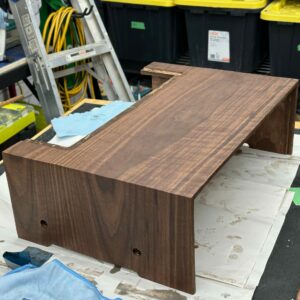The 1439 post about veneer. A few questions as I have a few issues.
I spent quite a bit of time going through the other veneer posts but most are quite old and none seemed to satisfy my issues.
I have been veneering speakers successfully for about 2 years. Yes I have been using contact cement and it has been very successful till I moved from Alberta to BC. A dry climate to a more humid climate. And yes I realize that contact cement is not the best choice but it worked for me until recently.
I have veneered 4 receiver cabinets in black walnut with a varying degree of success to failure. Knowing that contact cement is not the top choice I tried PVA wood glue. Gorilla Wood Glue to be exact. That was a complete disaster. after undoing the clamping it looked like wrinkled paper. So back to contact cement. Still some warping, splitting of the veneer and lifts here and there. Not my experience back in the dryer climate at all.
There is the history. Here are the questions. What is the best glue out there for veneer? Can you use vacuum bags for assembled projects such as receiver cabs? See photo. Any tips or trick you can offer is greatly appreciated. Trial and error is getting expensive and time consuming.















Replies
I have veneered in a small vac bag with pva, liquid hide, and Unibond 800. I veneer the panels before final sizing & assembly. Never thought about bagging a built box... in my mind the bag would tear or the box would deform.
Agreed. With vintage audio gear its all assembled and probably not a good idea to disassemble and veneer. So looking into other options. Cheers
OakWood veneer sells a craft paper backed and phenolic backed veneer, either would work well with contact cement if you want to continue to use it.
You can also use original titebond by coating both surfaces, letting it dry and ironing it on thus eliminating the need for clamping.
https://oakwoodveneer.com/
Lacking too much info for an informed answer.
How thick of veneer are you using?
Backed or not?
What substrate?
Maybe try Titebond Veneer glue.
For an assembled project such as your receiver cabinet in the photo, try hammer veneering with hot hide glue. Look at the articles and videos by Patrick Edwards on FWW.com. The entry cost is low, some hide glue and a veneer hammer.
If your veneer is coming out wrinkled it is either the glue or the clamping technique. You could use a vacuum bag, but it would need to be a bag that won't tear with sharp corners and you would need to build something to support the item in the press. A vacuum bag applies literally tons of force to a structure. If you use clamps, you need to get clamps into the center of the veneer. Hammer veneering is a non-clamping option and may be your best choice since it eliminates one of the two area that could cause your results.
As for glue, almost any glue will work for veneer and many good options are mentioned above. I use urea resin glue almost exclusively mainly for the longer open time. I have had times where a panel comes out flat and after a few minutes the veneer will begin to wrinkle if the glue hasn't cured or need to loose all the moisture to cure. I find that urethane glue works well in this situation or urea resin glue works well in this situation.
Your project looks great. Keep up the good work and let us know what eventually worked for you. I would like to learn from your trial and error as well.
I do a lot of vacuum pressing and I would think that the speaker cabinet might get crushed under the pressure unless it is built with internal ribs that will resist the compression. I don't think glue is the issue here, though I never use contact cement in veneering. If the veneer is not getting down flat it sounds like uneven clamp pressure. I have used veneer that has a glue back to it. You peel and stick and use a roller to give some extra pressure. Works very well on curves and you can cut it wherever you have sharp corners. This might solve your issues and it doesn't require any clamping.
The original titebond on both sides and iron on approach has worked well for me in the past with store bought veneer. Vacuum press is my favorite approach for thicker shop sawn stuff but like everyone else said it has a pretty solid chance of crushing the cab.
PVA and urea glues recommend 100-150 psi for softwoods, 125-175 psi for medium woods and 175-250 psi for hardwoods and a Vac bag pumps will do that much psi.
Or like Paul said:
https://www.joewoodworker.com/veneering/iron-on-veneering.htm
Check out the VeneerSupplies.com website - used their glues with excellent results for years on many projects. Really hard glue line which is perfect on non backed veneers. Even tried their heat activated variety which worked well.
I virtually always try to veneer flat stock before assembly in a vacuum bag - had a lovely (hollow) mantle get crushed in spectacular fashion in that bag even with internal ribs years ago so try to avoid veneering anything hollow now.